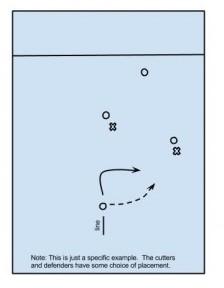Hi Lou,
I’d be interested in hearing your advice on the following question (though I’d also be quite happy to hear your advice in email format if you don’t want to post about it): From the perspective of a DIII school where most incoming players have never played before, what’s the best way to integrate them into ultimate and into practices? What’s the best way to get new players comfortable on the field, and what’s the most important skill set to work on first? Conversely, and while this is happening, how do you keep returners and more experienced players interested and improving while dedicating time to teaching the basics?
Thanks for your help!
TFYP,
Whether or not you believe it actually takes 10,000 hours to become an expert, there is no question that players need reps to acquire skills. Unfortunately, the classic warm-up, drill, scrimmage practice format that most teams utilize leaves new players little opportunity to touch the disc and since they often end up guarding each other, little opportunity to play defense either.
I am a huge proponent of Mini and other small-sided games like Hot Box and Goaltimate. They mean more touches, more defense, more excitement and more reps. You can shift and shuffle teams. Want to help the rookies? Make a team that partners them with your vets. Want to get your returners a challenge? Put them together on two teams and play each other. Want to get your rookies a chance to try handling? Put them all together. Because the games are so fast, they are low-cost and you can fit a lot of them into a single practice. You don’t need to be wedded to the ‘official’ rules. Oregon Fugue has found 4v4 to be a more useful tool than 3v3, so we play more of it, but 2v2 and even 1v1 have their merits, as does adjusting the field size.
~~~~~~~~~~
Hi Lou,
I volunteer as an ultimate frisbee coach at a middle school in Cambridge, MA, and one thing I’m keen to help the kids with is improving their field awareness. Mainly I’m thinking about from the perspective of a thrower with the disc. Some kids (some adults too, for that matter) seem to be afflicted with tunnel vision: they lock on to one person and fail to see poaching players on defense. Do you know of any good drills to run in practice that help promote field awareness, seeing the entire field at once, identifying the poacher and the poachee, etc.?
Thanks,
Shane
Shane,
This is a very difficult and sophisticated skill to learn. The challenge is to see everything while looking for something in particular. Another way to think of this challenge is that you want your players to see the entire field without an agenda, but if they have no agenda at all, they can’t make a judgement about what is a good choice. The trick is to fold your agenda into one of the things that you are observing along with the cutters, defenders, poachers, weather….
It would take a very sophisticated middle schooler to think that deeply, so here are a couple of drills. The first is a simple cut, read and throw drill illustrated in the diagram at right. The purpose of the drill is to train the eyes and mind to look at the whole field and make a decision immediately after catching the disc. There is a single line that initiates the action with a crossing pattern cut that runs about 5-yards deep. Downfield there are three offensive players and two defenders. The offensive players are spread out across the field in ‘cutting’ locations; as the throw goes up to the initiating crossing pattern, the defenders choose to cover two of the three offensive players. Upon the catch the thrower looks up, reads who is open and throws it to them.
The second drill is a fun one for middle school kids – it is called Zombie Defenders. This drill has multiple purposes. It practices quick, creative handler movement and reading open spaces as cutters and throwers. Set up a Mini field and prepare the teams to play 3 vs Everyone Else. The three are going to play regular ultimate and use a (creative) handler weave to advance the disc down the field.
The Everyone Else are zombies; they can’t run or jump and there are lots of them. If you are doing this with middle schoolers, they probably need more guidance about what defines acceptable zombie behavior, (but will also enjoy acting like zombies). This is an easy drill to be successful with if you can see the space and therefore good practice.
A last bit of advice is to adopt some sort of keyword like “see” or “scan” that cues the behavior practiced in the drill. Have the players yell this as they initiate the behavior (the step on the cut in drill number one, for example.) This emphasizes the learning and gives you something useful to yell from the sideline during games. Good luck and a big thanks for coaching middle schoolers.
~~~~~~~~~~
I’ve got add my two cents on the new Club Championship format. The timing of the announcement aside, the schedule isn’t bad provided the 1v4 game is eliminated. Pool play for nothing? For bracket seeding? Wasn’t there a regular season for a reason? Take out that 1v4 game and Thursday’s pool play becomes immensely interesting and meaningful.








Comments Policy: At Skyd, we value all legitimate contributions to the discussion of ultimate. However, please ensure your input is respectful. Hateful, slanderous, or disrespectful comments will be deleted. For grammatical, factual, and typographic errors, instead of leaving a comment, please e-mail our editors directly at editors [at] skydmagazine.com.